|
Sauces Defined | Other Common Sauce Terms
Sauces Defined
| Sauces are liquids of various thicknesses that are flavored or seasoned to enhance the flavor of food. Sauces can be sweet, sour, spicy, or savory and may be added to the food to become part of a main dish or used as an accompaniment to the food being prepared. Sauces add a variety of features to foods, such as complementing or enhancing flavors, adding an attractive appearance, and/or providing additional texture. |
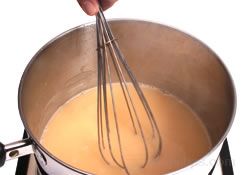
|
|
Initially perfected by the French, all sauces are now universally categorized into one of seven groups of sauces that are used as base sauces or foundations for other sauces known as secondary sauces. The primary sauces are known as Grand Sauces or Mother Sauces.
The following are the categories of the Mother Sauces of French cooking from which all other sauces are prepared.
- White Sauces (such as Béchamel Sauce)
- Brown Sauces (such as Madeira Sauce)
- Tomato Sauces or Red Sauces (such as Tomato Puree)
- Egg Yolk and Butter Sauces (such as Hollandaise Sauce)
- Egg Yolk and Oil Sauces (such as Mayonnaise)
- Oil and Vinegar Sauces (such as Salad Dressings)
- Flavored Butter Sauces (such as Beurre Blanc Sauce)
|
Other Common Sauce Terms
Reduction Sauce
A sauce made with the juices released from oven roasted or stove top cooked foods, such as meat, poultry or vegetables. The released juices become the base for the sauce, to which other ingredients may be added, such as wine, fruit juices, tomato paste, or bits of foods and herbs. The juice is boiled (or steamed) separately and stirred constantly to evaporate excess liquid (such as water), thus reducing the volume of the juices into a thicker consistency, providing a more intense flavor. The resulting liquid is strained and then used as a base for sauces, soups and stews. Gravies, meat sauces, wine sauces, and fruit sauces are all examples of reduction sauces that are used to enhance the flavor of foods being served. |
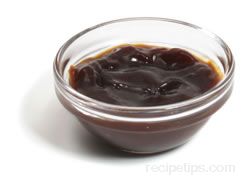
Demiglace Sauce
A brown sauce reduction |
|
A simple procedure for making a reduction sauce begins by removing the meat, poultry, fish, or vegetables from the pan containing the juices after the foods have cooked. Estimate the amount of juice remaining in the pan, and then add double that amount of water, wine, vermouth, liqueur, fruit juice, cream, milk, or any other liquid desired for the type sauce being prepared. On a stovetop burner, heat the combined liquids to boiling in order to evaporate the excess fluids. While doing this, stir continually and attempt to scrape the bottom of the pan to mix in any excess solids provided by the cooked foods in order to add flavor to the sauce. Cook the reduction sauce until evaporation decreases the sauce to half its beginning volume, turning down the heat to medium, being careful not to reduce the sauce too much, resulting in a somewhat dull tasting sauce with little aroma. Some sauces require additional thickening, so it may be wise to add a small amount of cornstarch or flour to thicken the consistency if necessary. Also, butter, extra-virgin olive oil, or cream can be added to provide a thicker or more flavorful sauce.
For sauces in which a nonalcoholic alternative is desired, use lemon juice, white wine vinegar, or verjus, which is a wine without alcohol. The acidity provided by a cup of the alcoholic ingredient can be replaced and balanced with a half cup of verjus, or use 1 to 2 teaspoons of lemon juice or white wine vinegar. It would be wise to add the amounts slowly, testing the results for the desired flavor before adding the entire amount of substituted liquid.
|
Secondary Sauce
A sauce that is derived from a mother sauce and has flavorings and seasonings added to create a new sauce. A secondary sauce is also referred to as a Small Sauce. |
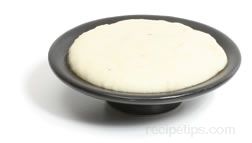
Mornay Sauce
A secondary sauce derived
from a white sauce base |
Small Sauce
A sauce that is derived from a mother sauce and has flavorings and seasonings added to create a new sauce. A small sauce is also referred to as a Secondary Sauce. |
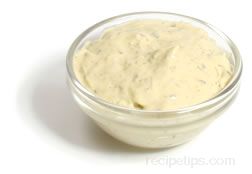
Béarnaise Sauce
A secondary sauce derived from
an egg yolk and butter sauce
(Hollandaise Sauce) |
Finishing Sauce
A term commonly applied to mixtures that are served over various foods either as it finishes cooking or for use after it is served. As an example, a Finishing Sauce may be mixed into spaghetti as a pasta sauce or served as a topping over sliced pieces of roasted meat such as roast beef. Other types of Finishing Sauces may include red wine sauces, pepper sauces, béarnaise sauce, or mushroom sauces to name a few.
|
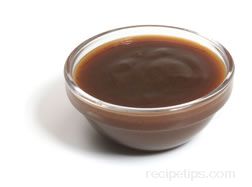 |
Pan Sauce
A sauce made from the juices left after pan-frying or sautéing food. It is served along with the food that is fried or sautéed. |
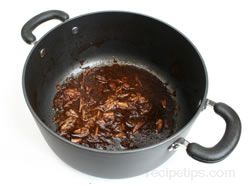 | |






